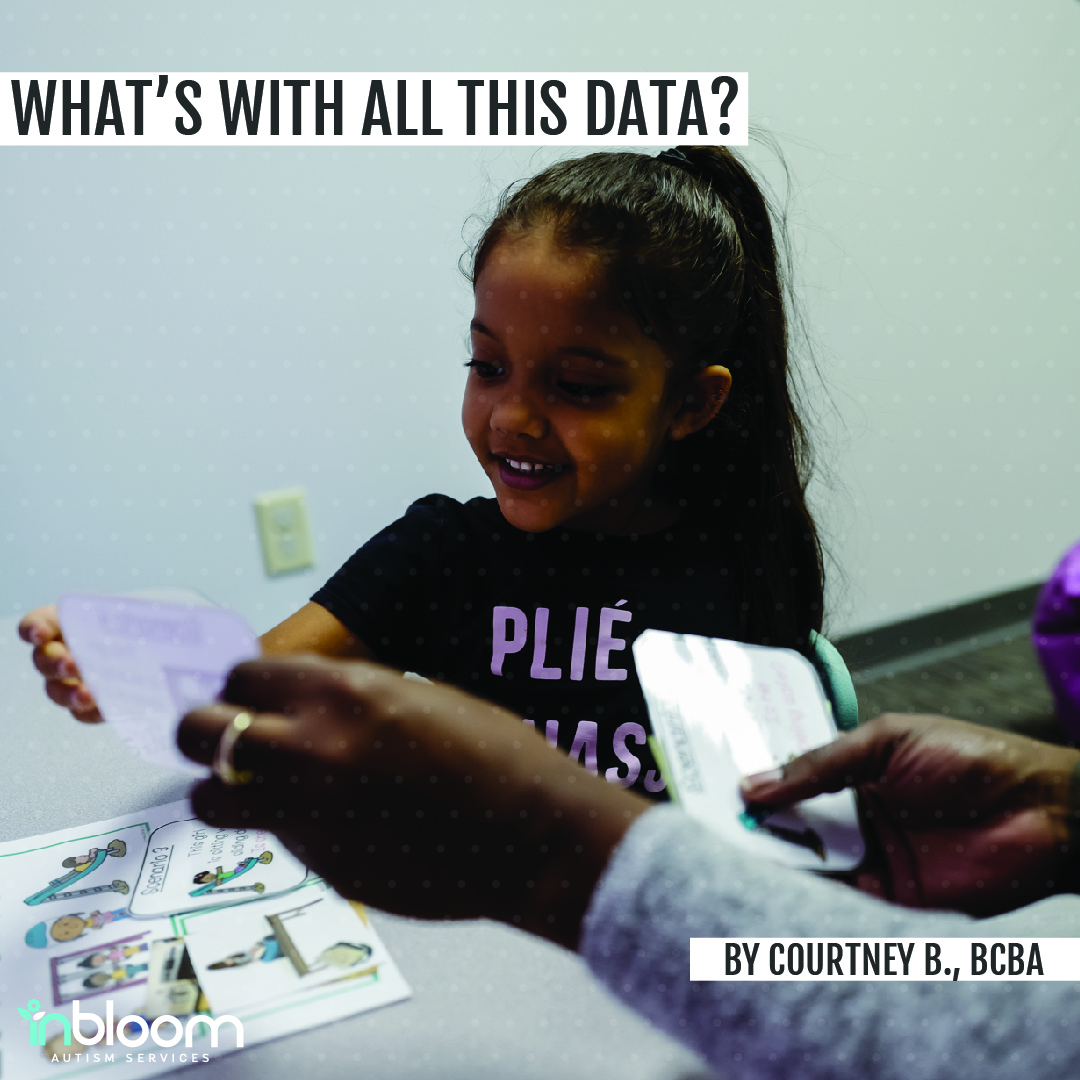Why Data Collection Is Essential in ABA Therapy

If your child is on the journey of Applied Behavior Analysis (ABA) therapy, you may have heard the word “data” multiple times when it comes to your child’s ABA program. Phrases like “the data suggests,” “let’s look at the data,” and “please show me the data” may be used often in caregiver support meetings.
You may have been asked to collect data on your child at home. Let’s talk about what ABA therapy data is and how it can help your child meet their goals and have a positive, effective therapy experience.
What Is Data Collection in ABA?
In the world of ABA, collecting data means gathering information that measures a quantifiable aspect of a behavior. That’s a mouthful! It’s really quite simple, though. For example, a child with autism may experience frequent meltdowns. But why?
Parents or a Board Certified Behavior Analyst (BCBA) may note and track any events that happen just before said behavior that may cause this behavior, looking for a pattern. This is an example of data collection in ABA. You might be starting to see why it’s important!
Defining Data in Behavior Analysis
To put it simply, you can think of data as observable or measurable information about your child’s behavior and their response to ABA therapy.
Examples of Behaviors Measured in ABA Therapy
Data gathered as part of ABA therapy might include:
- Behavior patterns.
- Events before or after a behavior.
- Interventions that have been tried.
- A child’s response to therapy techniques.
Why Data Collection Is So Important
Why do we collect so much data in ABA therapy? There are several important reasons, all aimed at ensuring your child experiences the best possible outcomes, including confidence, independence, and mastery of essential life skills.
Ensures Treatment Is Working Effectively
At InBloom, collecting data enables your child’s therapist to ensure their tailor-made ABA therapy program is working well for them. Measuring and tracking your child’s progress and response to therapy helps us ensure everything’s on the right track.
Guides Program Adjustments Based on Objective Information
Data is also used as a tool to navigate the direction of your child’s treatment program. The data is analyzed, and information from the data may be used to modify or discontinue a specific program if it seems the current approach is not as effective as it should be. Analyzing data in ABA allows for an objective view and ensures the best therapy experience.
Types of Data Collection Methods Used in ABA
Your child’s therapy team may use a variety of data collection methods. Let’s look at some of these.
Frequency and Rate Recording
ABA terminology may be a bit daunting (check out our article “ABA Speak Is Weak”), so let’s unpack this a bit. “Frequency” refers to how often a child does a specific behavior, and “rate” refers to how often the behavior happens during a given time.
Duration and Latency Recording
While “duration” refers to how long a behavior lasts, “latency” is a measure of how long it takes a child to start a behavior after a prompt or cue. For example, how long did it take Johnny to raise his hand to ask a question after the therapist prompted him to do so?
ABC (Antecedent-Behavior-Consequence) Data
You may be asked to gather ABC data about your child based on your observations of their behavior at home. Let’s break this acronym down a bit:
- A (Antecedent). What event happened right before a child’s behavior?
- B (Behavior). What exactly is the behavior being analyzed?
- C (Consequence). What happened immediately after the behavior?
ABC data is a way to format and collect data in a clear and objective way to observe patterns and draw conclusions that can guide therapy.
What Happens to the Data After Collection?
Regardless of the type of data collected, your child’s BCBA will look at the information and use it in important ways to guide therapy:
- Analyzing Trends and Progress Over Time. Data can help answer some vital questions. Is your child’s learning heading in the right direction? Are they making progress toward their goals?
- Making Data-Driven Treatment Decisions. What ABA therapy techniques would be most helpful for your child? Data can help direct and shape your child’s therapy plan.
- Adjusting Programs Based on Measurable Outcomes. ABA therapy data might show your child’s therapy team that adjustments should be made to their therapy plan. Further data can show if these changes are having the desired effect in helping your child with autism learn new skills and meet their goals.
The Parent’s Role in ABA Data Collection
As your child’s parent or caregiver, we recognize the valuable, central role you play in their life. For ABA therapy to be as beneficial as possible for your child, your involvement is critical. You’re not alone in this, though. Our experienced and helpful BCBAs connect with you in regular meetings to provide personalized coaching.
Collecting Data at Home Between Sessions
Data collection can be exciting, as it reveals helpful information about the current approaches being used in your child’s ABA program. As parents of children participating in ABA, there are plenty of opportunities to practice data collection outside of ABA support sessions. This information not only supports your BCBA’s recommendations but also helps you stay informed.
Tracking your child’s behavior over time may uncover important patterns. For example, you might notice meltdowns happening around the same time each day. With consistent notes, you can see whether your responses are helping to reduce those behaviors.
Using Data to Support Long-Term Growth
Although numbers, graphs, and data can be intimidating, the information you collect will help you and your child’s therapy team support their overall growth and learning.
Have Questions? Partner With Your ABA Team
Your child’s BCBA is a valuable resource throughout their ABA therapy. We invite you to reach out to them to discuss data collection and get any help you need in navigating this important process.
Starting Your Journey With InBloom Autism Services
If you haven’t yet started an ABA therapy journey with InBloom, contact our helpful team today to learn at 888-754-0398.
Courtney B. comes to InBloom with over 6 years of experience as a BCBA.
She obtained her M.Ed from Texas State University with a focus on autism. Courtney comes from a military family and has had the opportunity to experience the great city of San Antonio for many years. Courtney likes to read anything on the Royal Family and take walks with her dachshund, Peanut.



